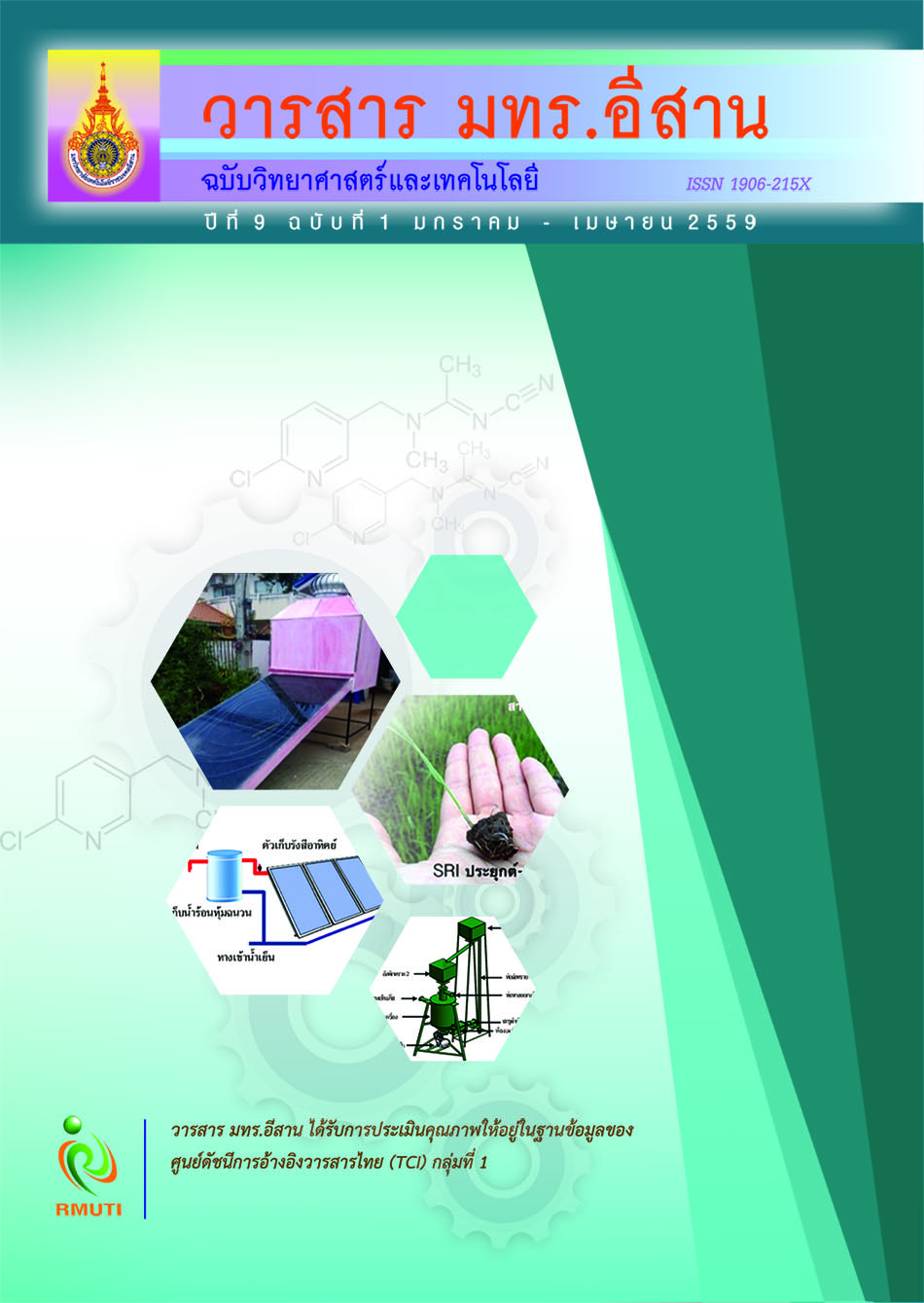ความน่าจะวิบัติของเสาสั้นคอนกรีตเสริมเหล็กภายใต้ความไม่แน่นอนของคุณสมบัติเหล็กเสริมในจังหวัดนครราชสีมา (Probability of Failure of Reinforced Concrete Short Column under Uncertainty of Properties of Reinforcing Bars in Nakhon Ratchasima Province)
Main Article Content
บทคัดย่อ
บทคัดย่อ
บทความนี้เป็นการศึกษาความน่าจะวิบัติของเสาสั้นคอนกรีตเสริมเหล็กรับแรงอัดตามแนวแกน สำหรับ
ที่พักอาศัย ซึ่งออกแบบด้วยวิธีหน่วยแรงใช้งาน การศึกษานี้คุณสมบัติตัวแปรสุ่มที่นำเสนอในรูปข้อมูลสถิติ
คือ ขนาดเส้นผ่านศูนย์กลางเหล็กเสริม กำลังที่จุดครากของเหล็กเสริม กำลังรับแรงอัดของคอนกรีต
และนํ้าหนักบรรทุกจร ซึ่งได้นำมาพิจารณาร่วมกันเพื่อคำนวณความน่าจะวิบัติเสา โดยข้อมูลดิบของ
คุณสมบัติเหล็กเสริมเป็นการรวบรวมผลทดสอบในจังหวัดนครราชสีมาเท่านั้น การคำนวณความน่าจะวิบัติ
ตั้งบนพื้นฐานวิธีจำลองสถานการณ์แบบมอนติคาร์โลและทฤษฎีความน่าจะวิบัติ ผลการวิเคราะห์แสดงให้เห็นว่า
การประเมินความน่าจะวิบัติควรอ้างอิงวิธีกำลัง ซึ่งเหล็กเสริมขนาด DB12 DB16 และ DB20 ให้ผลลัพธ์
ที่เหมาะสมกว่าเหล็กเสริมขนาด DB25 สาเหตุเนื่องจากความไม่แน่นอนของคุณสมบัติทางสถิติของเหล็กเสริม
นอกจากนี้ยังพบว่าแนวโน้มค่าที่เหมาะสมของนํ้าหนักบรรทุกจรคงที่ในการออกแบบ และตัวคูณลดกำลัง
เหล็กเสริมมีค่าเท่ากับ 200 kg/m2 และ 0.50 ซึ่งความน่าจะวิบัติกรณีดังกล่าวมีค่าตั้งแต่ 0.3 x 10-5 ถึง
2.0 x 10-5 น้อยกว่าค่าความน่าจะวิบัติเป้าหมาย 3.5 x 10-5 เนื่องจากผลการวิเคราะห์ขึ้นกับข้อมูลทางสถิติ
ของตัวแปรสุ่ม โดยเฉพาะข้อมูลคุณสมบัติของเหล็กเสริมที่รวบรวมในจังหวัดนครราชสีมา ดังนั้นควรมีการเก็บรวบรวมข้อมูลคุณสมบัติเหล็กเสริมให้มีจำนวนเพิ่มขึ้น เพื่อนำไปใช้ปรับปรุงมาตรฐานการออกแบบด้วยวิธีหน่วยแรงใช้งานของประเทศไทยต่อไป
Abstract
This article proposed the results of the probability of failure of the reinforced
concrete of short column which was under the axial compressive load for residential
building. The column was designed by the Working Stress Design (WSD) method.
In this study, the statistical properties of random variables such as diameter of
reinforcing bar, yield strength of reinforcing bar, compressive strength of concrete
and live load were considered together to calculate the probability of failure of column.
The raw data of properties of reinforcing bar were collected from the tested results
in Nakhon Ratchasima province. The analysis process of the probability of failure
based on the Monte Carlo Simulation Method (MCSM) and the Probability of failure
theory. The results revealed that the assessment of the probability of failure
base on the Strength Design Method (SDM) which the analysis results from the
reinforcing bar size DB12 DB16 and DB20 were more appropriate than bar size DB25
due to the uncertainty of the statistical properties of reinforcing bar. Furthermore,
the appropriate live load and strength reduction factor of reinforcing bar were
200 kg/m2 and 0.50. The probability of failure of this case was 0.3 x 10-5 to 2.0 x 10-5 which
was less than the criteria of probability of failure. Due to the analysis results
depended on the statistical data of random variables that were collected in only
Nakhon Ratchasima province, therefore, the properties data of reinforcing bar
should be collected more data to improve the standard of Working Stress Design of
Thailand.
Article Details
เอกสารอ้างอิง
Chovichien, V. (2009). Reinforced Concrete Design (Working Stress Design : WSD).
5th ed. Bangkok
Chovichien, V. and Chovichien, V. (2011). Reinforced Concrete Design (Strength Design
Method : SDM). 5th ed. Bangkok
Jiravacharadet, M. (2006). Reinforced concrete design, Working stress design method,
strength design method. 4th ed. School of Civil Engineering, Suranaree University
of Technology, Nakhon Ratchasima
Mekaroonkamon, K., Prasitviriyakul, S. and Smittakorn, W. (2003). Comparison of WSD
and SDM for reinforced concrete structures : a case study. Civil Engineering
Project, Academin Year 2002. Faculty of Engineering, Chulalongkorn University,
Bangkok
Suchinda, C. (2007). A parametric study for choosing appropriate allowable stress for
rebars in the design code. The 12nd National Convention on Civil Engineering.
May 2 - 4, 2007
Suchinda, C. (2009). The strength reduction factors for reinforced concrete design
standards based on Thailand statistical data. The Research Report of Sripatum
University. Bangkok
The Engineering Institute of Thailand under H. M. The King’s Patronage. (2010). EIT.
Standard 1007-34. 11th ed. Bangkok
The Engineering Institute of Thailand under H. M. The King’s Patronage. (2012). EIT.
Standard 1008-38. 8th ed. Bangkok
Vongchavalitkul, S. (2014). Uncertainty model of concrete elastic modulus effect to critical
reinforce concrete buckling load. The 19th National Convention on Civil
Engineering. May 14 - 16, 2014
Vongchavalitkul, S. and Boonsuan, W. (2005). Effect of reinforcement ratio to reliability
index of beam. KKU Engineering Journal. Vol. 32. No. 2. pp. 173-181
Wattanasupt, S. (2005). An investigation of the appropriate live loads for buildings design.
Master of Engineering. Faculty of Engineering, Civil Engineering, King Mongkut’s
University of Technology, Bangkok
Yodmuang, P. (2008). An investigation of the live loads for residential buildings and
convenience building. Master of Science in Industrial Education. Faculty of
Industrial Education and Technology, Civil Technology Education, King Mongkut’s
University of Technology, Bangkok


